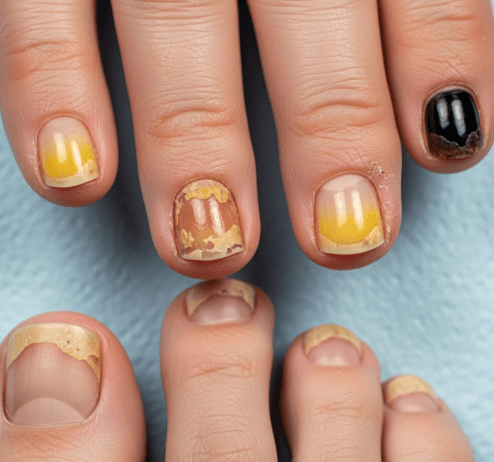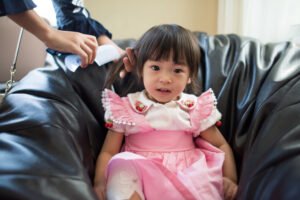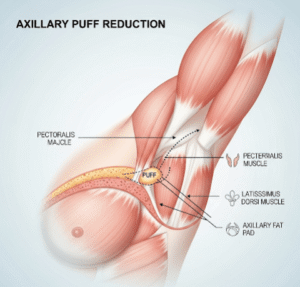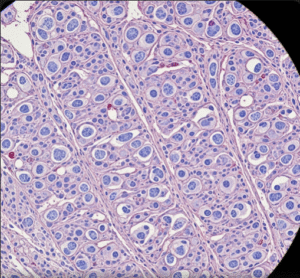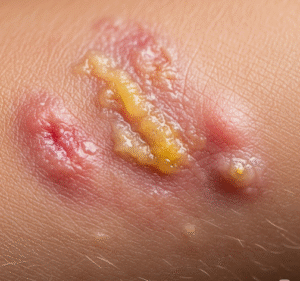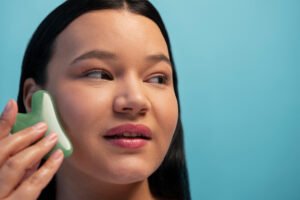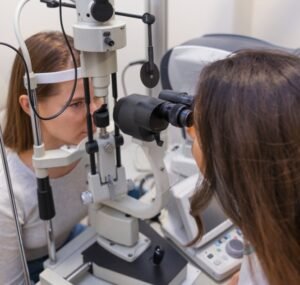What It Is
Defining Nail Fungus
→ Nail fungus (onychomycosis) is a common infection caused by fungi (dermatophytes, yeast, or molds) that invade fingernails or toenails.
→ It leads to thickened, brittle, yellow, or brown nails, often accompanied by discomfort, odor, or difficulty trimming.
→ Traditional treatments include oral antifungal medications and topical antifungal solutions, but these often require months of use and may have limited success.
Defining Laser Treatment for Nail Fungus
→ Laser therapy is a modern, non-invasive treatment where a focused beam of light penetrates the nail plate, targeting fungal organisms without damaging surrounding tissues.
→ The laser produces heat energy, destroying or inhibiting fungal growth while stimulating healthier nail growth.
→ In Korea, dermatology and podiatry clinics offer advanced laser devices (Nd:YAG, diode, fractional lasers) as part of nail fungus care.
Key Characteristics
- Safe and painless compared to surgical nail removal
- Usually requires multiple sessions for best results
- No systemic drug side effects (unlike oral antifungals)
- Often combined with topical or oral therapy for improved success
Why It’s Done
Main Reasons for Laser Treatment
➡ Drug Limitations – Oral antifungals can affect the liver and are unsuitable for some patients.
➡ Low Compliance with Topicals – Topical solutions require daily use for months and often fail.
➡ Quick, Non-Invasive Option – Patients prefer a needle-free, pill-free method.
➡ Cosmetic Improvement – Clears thick, discolored nails, restoring confidence.
➡ Minimal Downtime – Patients return to daily life immediately after sessions.
Alternatives
Non-Medical Options
- Regular Nail Hygiene → Keeping nails trimmed, dry, and clean.
- Footwear Adjustments → Using breathable shoes and cotton socks.
- Vinegar or Tea Tree Oil Soaks → Popular home remedies, though not highly effective.
Medical Alternatives
→ Traditional therapies available if laser is not chosen:
- Oral Antifungals → Terbinafine, itraconazole (effective but risk of liver toxicity).
- Topical Antifungal Solutions → Ciclopirox or efinaconazole nail lacquers.
- Surgical Removal → Rare, for severe or resistant cases.
Preparation
Before Laser Treatment in Korea
➡ Dermatology Examination – Confirm fungal infection through nail scraping, KOH test, or fungal culture.
➡ Assessment of Severity – Number of nails, thickness, and degree of discoloration.
➡ Discussion of Expectations – Patients informed that healthy nail growth takes months, even after fungus clearance.
➡ Pre-Treatment Care – Nails may be filed or thinned to allow better laser penetration.
➡ Medical History – Review of medications, liver function, and previous antifungal treatments.
How It’s Done
The Laser Procedure in Korea
Step 1: Cleaning and Preparation
- Affected nails are trimmed and filed to remove excess thickness.
- Nail surface may be disinfected before treatment.
Step 2: Laser Application
- Dermatologist uses a handheld laser device that emits focused heat.
- The laser penetrates the nail and nail bed, targeting fungal cells.
- Patients may feel mild warmth or tingling, but pain is minimal.
Step 3: Session Duration
- Each session lasts 15–30 minutes, depending on the number of nails treated.
Step 4: Repetition of Sessions
- Most patients require 3–6 sessions spaced 4–6 weeks apart.
- More severe cases may need additional treatments.
Step 5: Combination with Adjunct Therapies
- Korean clinics often combine laser with topical antifungals or debridement for higher success rates.
Recovery
Immediate Recovery
- No downtime; patients walk out of the clinic normally.
- Nails may appear the same initially, as improvement is visible only as new healthy nail grows.
Long-Term Recovery
→ Nail growth is slow:
- Fingernails → 4–6 months to replace
- Toenails → 12–18 months to replace
→ With consistent care, patients see clearer, healthier nails as fungus is eliminated.
→ Korean dermatologists emphasize maintenance hygiene to prevent recurrence.
Complications
Risks Without Treatment
- Thickened, painful nails that are difficult to trim.
- Spread of fungus to other nails, skin, or family members.
- Secondary infections in diabetics or immunocompromised patients.
- Chronic discomfort and cosmetic distress.
Risks With Laser Treatment
- Mild Discomfort → Temporary warmth or tingling.
- Temporary Redness → Fades quickly after session.
- Incomplete Clearance → Some cases may relapse if hygiene is poor.
- Multiple Sessions Required → Not a one-time cure.
Treatment Options in Korea
Why Korea Excels in Nail Fungus Laser Care
➡ Access to Advanced Lasers – Nd:YAG, diode, and fractional lasers widely available.
➡ Integrated Approach – Laser combined with debridement, topicals, or systemic therapy if needed.
➡ Focus on Cosmetic Outcomes – Clinics emphasize restoring clear, natural-looking nails.
➡ Specialized Foot Clinics – Many hospitals in Korea have dedicated nail and foot care centers.
➡ Patient Education – Emphasis on hygiene, footwear, and prevention.
Patient Experience in Korea
- Outpatient procedure with minimal pain and no anesthesia required.
- Stepwise treatment plan explained clearly, often with before-and-after photos.
- Follow-up visits monitor new nail growth and adjust care as needed.
- Many clinics offer aftercare kits including antifungal sprays, creams, and hygiene instructions.
Conclusion
Nail fungus laser treatment in Korea is a modern, effective, and patient-friendly solution for onychomycosis.
By using focused heat energy to destroy fungal cells without systemic side effects, Korean dermatologists provide a safe alternative to oral antifungals.
Through multiple sessions, combined therapies, and strong emphasis on prevention, patients achieve both clearer nails and long-term control of infection.
With Korea’s cutting-edge laser technology, integrated care systems, and cosmetic expertise, it is one of the best destinations worldwide for nail fungus treatment.

